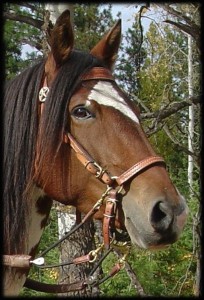Richard Caldwell has a great video about starting a colt on a Jaquima which you can order by clicking HERE.
_________________________________________________________________________________________________________
From the PLF, Inc website
A Jaquima is a Colombian equine headstall, complete with a nose band (bosal) and chin strap (curb). The Jaquima was originally brought to this country with the Paso Fino and is the traditional training bridle for them. Some Jaquima’s are sold in a set with a Bit Hanger and Pisador (life line).
The Pisador is a rope that loops around the horses throat and goes down through the curb and is tied off at the saddle. It sometimes takes the place of the throat latch and is sometimes separate. It is 15 to 20 feet long and is a training aid as well as a lead rope for tying up the horse.
The original Jaquimas were mainly made of rawhide, but today they can be found made of high quality leather and also synthetic materials, all for the same purpose but for different disciplines; show, training, trail.
You must train your horse to use the Jaquima in the same way you would train them to use the Side Pull or Bitless Bridle. The cheek pieces of the headstall have buckles or snaps so that the bosal and curb can be changed easily. For beginning training, you should use a soft bosal and curb, as green horses have a tendency to push and pull a lot until they figure out what you want. The soft bosal and curb are less likely to cause soreness.
Position the bosal (nose band) to hang just above the soft part of the nostrils so it rests on the bony part of the nose. Very seldom would a trainer let it hang lower, as it could cut off air flow. In the same way, do not position it too high on the nose. The higher the bosal, the more likely the horse is to nose-out.
The severity of the bosal needed is completely dependent on your horses sensitivity and degree of training. They come in many forms; chains, covered wire, covered rope, and leather of different widths and thicknesses. Just like bits, a noseband can be severe or gentle by how you use your hands.
The Curb (chin strap) comes in different degrees of severity also. Like the bosal, a light or soft curb is used to start young horses until they figure out how to give. Then you can change it to match the horse or the discipline. For instance, when trail riding, we use a heavy stiff curb and no bit. When we pull back, we want our horse to definitely feel it. The curb is as severe as your hands just like the bosal.
The Curb has two rings hanging from the bottom and a piece of leather or snap that runs between them. Each side of the curb has a leather strap that runs up through the bosal ring and back down to buckle. The curb should be loose enough to fall down and away from the horses chin when you are not pulling on it. I have seen some that have been so loose that they can pull down over the mouth, and some so tight that the horse cannot open its mouth, both bad extremes. If you can put a fat finger between your horses chin and the curb it is probably OK. When the bosal is raised and lowered, you nearly always have to readjust the curb too.
The Jaquima is a lateral tool. This means you always pull on one side at a time. Just like a snaffle bit, if you pull straight back with both reins, your horse will learn to pull into the pressure and be heavy or tough mouthed. Just like a snaffle, if you teach the horse to give he will be light in your hands. To start, use one rein snapped to the side ring (the ring on the end of the bosal). When the horse learns to give the nose to the left and right, then put a second rein on the bottom rings and use the reins together for lateral flexion. It will be a different feel for the horse. The next step would be to drop the side rein and control the horse from the chin only. When it is time to add a bit, the second rein is again added to the bit.
It is a process of graduation from the Jaquima to a bit without resistance. A finished refined horse can be ridden in the bit only, but can work well in only the Jaquima, or both the bit and Jaquima double reined. I have seen many trainers drop the rein off the bridle and snap it to the curb when letting people they do not know ride their horses. This is to protect their horses mouths from untrained hands. The horse may not be as refined, but they work well because they have been trained to the Jaquima.
As trail riders, we love the Jaquima alone. On our trained horses we use a stiff/heavy curb and a noseband that compliments the horse. On one horse we use a chain bosal, as he would love to take his head and go his own way; not too sensitive. But on another we may use a soft leather 3/4″ bosal; very sensitive. The curb never touches the horse unless we pull on it, so it does not need to be soft on a sensitive horse. The severity comes from the hands.
I hope this helps those of you who are curious about the Jaquima and who may want to give it a try. It is a fantastic tool. Most are made specifically for the Paso Fino, and may be too small for other breeds. So before buying, take measurements to be sure they will fit.
If you have problems seeing the video below click HERE
.youtube::efC4gY1KJW0::

